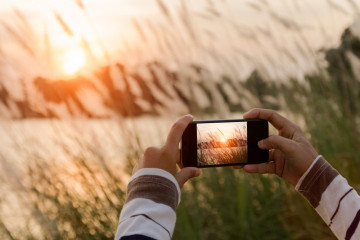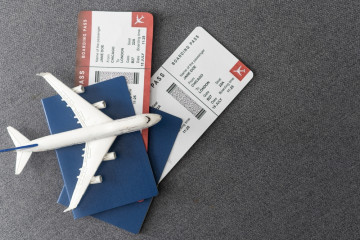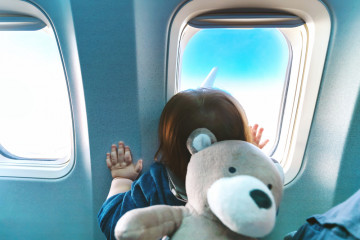Travel shots. Travel photography is a form of photography that involves capturing the landscape, people, cultures, customs, and history of a location. According to the Photographic Society of America, the travel photos is an image that captures the essence of a time and place, depicts a country, its people, or a culture in its natural state, and is not limited by geography.
But not everyone is proficient in photography techniques, and especially in travel photography. With Moustache’s quick guide to travel photography tips, you can enhance your travel photography skills, just by normal adjustments in lights, composition, and other common factors.
Hereby enlisting the photo tricks and photography tips for beginners to capture the perfect travel shots. Let’s, take a look at the list.
1. Have a Good Lighting
As one of the important photography tips, a good lighting makes a huge difference in the creation of a good picture. Not only does lighting affect brightness and darkness, but it also affects sound, mood, and atmosphere. As a result, to achieve the best texture, color vibrancy, and luminosity on your subjects, you must correctly monitor and manipulate light. You can create stylized professional-looking photographs by correctly distributing shadows and highlights.
2. Composition
Human eyes are always looking for patterns and symmetry. Let be any shape, any architecture, color, or any physical form, human brains complement some sorts of order that complement each other. As our brains are drawn to the patterns for a variety of reasons.
Understanding these trends and what makes the human brain happy is a quick way to improve your photography. And that is what photography composition is all about.
However, before we get started on these photography tips, there are a few things to keep in mind. To begin photo taking, make sure your camera is level. Wonky horizons are a no-no. They’re the visual equivalent of nails on a chalkboard, and your brain doesn’t like them.
Next photography techniques, is to stop blurry pictures, keep your hands as still as possible when shooting. Keep your camera steady in both hands, or use a tripod. This photography tricks is equally applicable to all sorts of photography and considered to be one of the basic photography tricks.
3. The Rule of Thirds
The Rule of Thirds is one of the most important compositional principles while taking travel photos. As per the rule of thirds, a picture should be divided into three equal parts viz. vertically, horizontally, or both. The aim is to fill those thirds with important compositional elements. And, no matter if you are using a DSLR or your smartphone, you can apply the rule of third by locating the option to enable a grid over the preview screen on your smartphone or tablet (enabled in DSLRs). Can be taken as an important mobile photography tricks as well. Two vertical and two horizontal lines will appear and you are good to go.
As per this photography techniques, these points are normally where we focus first on a picture. Placing the subjects on intersecting points will naturally attract the viewer’s attention to them, and this is a great starting point for a good composition. PS: Sunsets and sunrise are one of the favourite subjects to practice this travel photography tricks.
4. Use Shapes, Curves, and Perspective to your advantage
The mood of a photograph can be influenced by its shapes and types. Apart from other photography tips, the shapes, textures, and lines can also contribute to the overall feel of a portrait, just as a certain color can elicit various emotions. As per this travel photography tips, one can understand how each aspect contributes to the mood of an image. Ultimately, helps you to manipulate your travel photos, composition, exposure, and other elements to elicit the emotion.
According to the best travel photographers, it is advised that Rounded shapes like circles and ovals give the impression of movement, since they lack corners and edges.
On the other side, squares and rectangles, with their smooth edges and sharp corners, evoke a sense of stability.
Triangles in photography draw the viewer’s attention to the triangle’s point. When you turn the triangle upside down, with the point down, the lack of a proper foundation gives the impression that the form is off-balance.
Irregular shapes of different length sides can also give an image a tense feel. In the case of lines, the image’s emotion is influenced by the line’s direction.
Since diagonals appear to be moving, they give the impression of movement inside the picture. These lines also draw the eye to the point where the line is pointing. A leading diagonal line that extends into the distance will add dimension to an image.
A horizontal line, on the other hand, is more commonly associated with a calm or peaceful picture, while a vertical line evokes a sense of strength or stability. Curved lines would have the same effect as circles and ovals in terms of creating a sense of motion.
Apart from shapes, perspective is another important consideration when capturing a 3D world for a 2D picture. Different angles produce different shapes of the same 3D structure, as we all know. When viewed from the head, a coffee mug, for example, appears to be a cylinder with a curved line as a handle. From top to bottom, the same cup is a full circle. For many things, changing the perspective will cause them to take on several shapes. A proper light arrangement onto the subject can also add depth and texture to the image. Finally, just by looking at a 2D image, you can get a good picture of what the subject looks like in 3D.
Furthermore, experimenting with shape by varying focal lengths can be a significant photography tricks, impacting the overall story behind any given picture. The lens you choose will have a big impact on how the shapes appear in your shot. Tilt-shift lenses correct the distortion caused by wide-angle lenses distorting straight lines. Also, remember to see lines, as they help to guide the viewer’s eye to the focal point and upscale the composition.
5. Foreground, Midground, and Background
Have you ever taken a shot of a mountain or a city skyline and later wondered why it didn’t manage to capture the beauty of what you were seeing?
This is most likely because your picture is a two-dimensional image, and you have lost the sense of scale that is present when you are in the moment. As one of the principle landscape photography tips, you should consider the various elements in the foreground, midground, and background of the shot when composing a shot.
Consider all around you while you’re out and about in the city, taking travel photos. If you see a distant mountain you want to photograph, look around to see if you can find anything interesting to include in the foreground or midground. If you live near a river, a canoe could be an option. It might be a house somewhere else. Alternatively, a flock of sheep. Alternatively, a car begins to climb a winding path.
If you’re filming a city scene, pay attention to what’s going on around you. Street vendors, various modes of transportation, as well as signs and storefronts, can all be used as a foreground to give your city skyline or that oddly shaped building background and scale. If you can’t find it, think beyond the box. To add size to your clip, find someone to stand in it. Just bear in mind not to overwhelm your audience with too many compositional elements and to keep the subject of the picture clear. You can make more balanced, appealing images by thinking about the large background sections of the picture and concentrating on the smaller components.
6. Perfectly Framed
Practised by some of the best travel photographers, this compositional technique isn’t about framing a picture; it’s about using the environment. The photo tricks to “frame” the subject you’re trying to capture, demonstrating what the shot is about and bringing the viewer’s eyes into the scene.
When you’ve found your subject, take a look around to see if there’s a way to creatively frame it. Vegetation, such as tree branches and vines, as well as doors and windows, are good framing choices.
The frame is much wider than the subject in this situation, but the subject is never obscured. One of the basic photography techniques, finding a good way to frame your subject can require you to scout around or step back from it. To get the picture you like, don’t be afraid to stand further away and use the zoom on your lens. There are several more travel photography tips talking about various framing options available. Make sure to experiment these travel photography tricks, while making your next trip.
7. Focus on the Focal Points
As discussed in the above photography tips, focus can play a major role to understand the depth of any composition. One way to ensure that viewers look at the part of the image you want them to look at is to make just a portion of the image sharp and in focus while leaving the remainder blurry.
Look at how much the subject of the shot is the only thing in focus in a wedding or sports photographs of people to see how effective this is for isolating people or animals in images. One of the common photography tips for beginners, is to set your camera to “portrait” or “people” mode.
8. It’s a perfect Color match
Have you ever noticed that all the blogs regarding travel photography tips, or street photography tips or basic portrait photography tips, have one pointer in common, that is Color. It is one thing that every photography tricks blog ignores to miss.
As per all major photography tips blog, color plays an extremely important role in all sorts of photo taking. In particular, how different the colors going to blend in the entire composition. Few basic photo tricks for color you can try is, blue with yellow (a field of sunflowers), and red with green (Christmas!).
Take a look at the color wheel to see which colors go well together.
Also practised as the mobile photography tips, colors that are opposite each other on the color wheel will usually complement each other. These colors don’t have to be equally matched in a shot; sometimes, a small percentage of one and a larger percentage of another works better.
Keep an eye out for contrasting and complementary colors that you can use in your photos while you’re out and about. Spice markets, historic European cities, rural meadows, and old colorful barns in green fields are all excellent places to begin.
9. Let the Lines lead your eyes
When creating a portrait, you want to make it as simple as possible for the viewer to determine the image’s subject and focus.
Leading lines — the use of natural geography or other features that the audience will instinctively look at first and which will lead their attention to the main subject — are one way to accomplish these photo tricks.
Bonus Photo Trick! If necessary, arrange subjects to create symmetry, or line them up diagonally to create balance in the frame. Objects like leaves or branches may also be used to frame subjects.
10. Storytelling: Behind the scenes
One of the final photography techniques is storytelling. As every best travel photographers agrees, there’s a lot more behind than just a perfect shot. The distinct advantage of the thrill and adventure to explore, and reaching the destination that no one else has. To them, a waterfall shot is just that — a waterfall shot. What happened on the five-hour trek through a leech-infested jungle to get there? I’m out of it. When you took a dip to cool off, remember how refreshing it felt on your skin? Likewise, it has vanished. It’s just a two-dimensional image on a screen that will be easily replaced by the next image in the series.
It’s up to you, how you utilize your travel photography tips to reintroduce all of the missing meaning.
An image is said to be worth a thousand words. It is your duty as a photographer to express those terms via your travel photography. Get the shots that entice your audience to join you in your story and the adrenaline rush behind. Your travel photos are such that it makes your shots resonate with your audience. Use as much empathy as possible to locate and freeze moments, ultimately adding the human element in your travel photography.
We recommend taking some time before taking your travel photos. Consider the shot you want to make, the moment you want to catch, and the story you want to tell your audience. Put yourself in their shoes and pretend you’re looking at the photo taking with no other background. From there, try to create the shot.
Travel photography is one of the most diverse genres in terms of subject matter. Some of the best travel photographers specialize in a specific type of photography, such as travel portraits, landscape photography, or documentary photography, in addition to covering all aspects of travel. Thus, it’s no different than any other photography. And, can be perfected only by practice. The more pictures you take, the better you’ll get at composing and capturing great images. So, take your camera and start clicking. After all, what do you have to lose?


